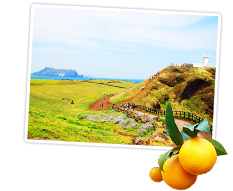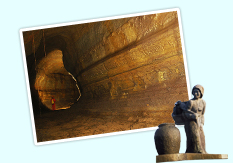|
|
Located southwest of the Korean Peninsula, Jejudo Island (제주도) is a
volcanic island in the shape of an oval that measures 73km from west to east,
and 31km from north to south. As Korea’s most southern region, the weather on
Jejudo Island remains significantly warmer than the mainland even during the
cold winter months. Jejudo Island is sometimes referred to as “Samdado Island”
(삼다도, meaning the “three many”) because of its abundance of rocks, women, and
wind. Wind from the ocean blows steadily throughout the year and past volcanic
activity has littered the island with an assortment of beautiful and
unusually-shaped black rocks. The island’s reputation of having an abundance of
women points back to the time when fishing was the primary means of income and
many men were lost at sea.
|
Unique Costal Culture and
Breathtaking Natural Beauty
|

Before the invention of modern means of transportation, travel to and from
the mainland was often a difficult and dangerous journey that few attempted.
Since the island was cut off from the mainland in this way, the people on the
island developed their own unique culture and dialect.
Out of this
culture was born a set of unusual icons that demonstrate the uniqueness of the
island: "Haenyeo,” "Dolhareubang," "Galot," and "Bangsatap."
Back in the
days when Jejudo Island was a land of fishing villages, the local women were
responsible for a large part of the family’s income. "Haenyeo” (해녀, female
divers) often went diving to collect shellfish and edible seaweed, filling the
quiet sea air with whistles announcing their catch.
Every visitor to Jeju
is sure to see their fair share of Dolhareubang (돌하르방, literally "old
grandfather stone statues”). Sometimes serious-looking, sometimes almost
comical, these statues dot the landscape and have become one of the most
widely-recognized symbols of the island.
The word “Galot” (갈옷) refers to
traditional Jeju clothing that is dyed with persimmon juice. Often associated
with the area’s agricultural way of life, these orange-hued, lightweight pieces
of clothing are a trademark of Jeju.
Another special sight are the
Bangsatap (방사탑) piled all around the island: at houses, beaches, and even
tourist attractions. These small, round towers made of many stones were thought
to ward off evil, protect the village, and bring prosperity to the people. It is
because of this deep-seated belief that one can still see Bangsatap near the
entranceways of many buildings.
In addition to having its own unique
culture, Jeju is full of breathtaking sights and unusual attractions: World
Heritage Sites (such as Hallasan Mountain and Seongsan Ilchulbong Peak) and
sandy beaches alongside turquoise waters. Small mountains ((called Oreum (오름) in
Jeju dialect)) are found all across the island. There are said to be more than
365 oreums, more than one for each day of the year! The "Jeju Olle" paths offer
a great opportunity to explore this unique landscape, leading visitors among
quiet places off the beaten path.
Jeju’s phenomenal natural beauty,
historical legacies, quirky museums, and array of water sports make it one of
the best vacation spots in Korea.
|
>> World Heritage Sites by UNESCO on Jejudo
Island
|

Among all of Jeju’s natural wonders, three sites have been recognized as
World Heritage Sites by UNESCO (2007): Hallasan Mountain, Seongsan Ilchulbong
Peak, and the Geomunoreum Lava Tube System. Hallasan Mountain is perhaps Jeju’s
most prominent geographical feature, rising out of the very center of the
island. Seongsan Ilchulbong Peak has been recognized for its sedimentological
characteristics and is one of the best places in the world to study
Surtseyan-type volcanic eruptions. The third and final World Heritage Site is
Geomunoreum Lava Tube System, one of the most extensive series of lava tube
caves in the world.
|
☞ More Info - Hallasan National Park
☞ Related
Links -
Jeju Volcanic Island and Lava Tubes
- Best 3 Tourist Sites Designated as World Natural Heritages in
Jeju
☞ Columns about Jejudo Island |
~ cerita si gadis sepi ~
Monday, July 15, 2013
Subscribe to:
Posts (Atom)








